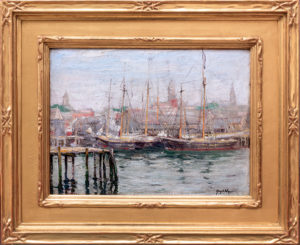
Guy Wiggins
(1883-1962)
It is said of Guy Wiggins that his classical approach to broken-color Impressionism ushered out the popular acceptance of this style of painting (which he adhered to and never abandoned), yet he lived long enough to see it reemerge and gain popularity. Wiggins painted many subjects and locales, but his Hassam-inspired New York City snow scenes, often with flags whipping about in the snow-filled winds, became his signature image. My first example by Wiggins was purchased in 1972 from Marbella Galleries, and it depicts the distinctive shape of the Flatiron Building, favored by artists and photographers for decades. At this stage Wiggins was definitely thought of as a “poor man’s Hassam”—a viewpoint that would change dramatically in another twenty-five years or so. It was at some point in the early 1980s that I became aware of Wiggins’ painting in Cape Ann when I saw an extraordinary Gloucester picture at Bonnie Crane’s in Boston, a sharply angled composition and intensity of blue water that virtually eliminated all the other paintings surrounding it. I recall thinking, “I don’t know when he painted on Cape Ann, but I gotta have this picture.” About a decade or so later, a second, smaller, but equally intense Gloucester picture was located right in my hometown at Butler Gallery. By the 1990s, Wiggins’ reputation and desirability were strong, and even his Gloucester images were well-respected. I was wandering through an art and antiques exhibition, possibly in Wilton, Connecticut, and spotted an outstanding little Wiggins at John Formicola’s booth to be informed that it was a highly desired Cape Ann image and priced accordingly. Ah, the rug trader instincts emerged: I waded in with “These type boats are not American; the sails are brown, which is also wrong… it’s clearly a less desirable St. Ives image from the artist’s brief trip to Cornwall in 1914.” As the exhibitor’s confidence in the picture was briefly shaken, a new price was struck and both parties were happy. A possibly apocryphal story surrounds the always pragmatic Guy Wiggins, that he was seated in his studio during a raging snowstorm in New York, trying unsuccessfully to paint a summer landscape, when he looked out his window and viewed a train whizzing by on an elevated railroad track; the train, the tracks, and the buildings partially obliterated by the whirling snow. Yes, you guessed the rest: he feverishly painted a series of city snowscapes for his next exhibition, prompting the artist to say, years later in an interview, “The winter canvases were sold before anything else. In a week, or so to say, I was established as a painter of city winter scenes, and I found it profitable.”1 The last two pieces by Wiggins were acquired in the late 1990s, a delightful, strongly colored view from within Central Park gazing back toward Central Park West and, in my humble opinion, the best of the artist—an early 1920s snow piece entitled Out My Studio Window depicting (I believe) the southern end of Central Park looking across Fifth Avenue. Perhaps the “looking out my studio window” story is true after all.